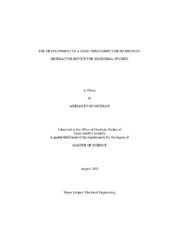| dc.description.abstract | Microdroplet microfluidics has gained much interested in the past decade due to its ability to conduct a wide variety of biological and microfluidic experiments with extremely high repeatability on a mass scale. In particular the ability to culture multiple batches of cells by creating microdroplets with a single encapsulated cell and observe their growth overtime allows for specific conditioning of cells. In addition, when conducting co-culture experiment the induction of a certain stimulus may provide observational rare differences in growth that may be characterized by harnessing a single batch of cells out of thousands of samples.
This thesis first presents a variety of microdroplet microfluidic devices that use specific techniques to sufficiently produce, synchronize, merge, and analyze microdroplets. Although many of the devices are capable of producing stable droplets and somewhat efficient synchronization, the overall merging efficiency for most passive or active merging methods alone is lacking. Improvements on such methods and the incorporation of multiple merging methods can lead to a higher overall merging efficiency and greater droplet stability. Also, multiple droplet detection methods can be employed to analyze cellular growth under different conditions, while passive or active sorting methods can be used to acquire particular microdroplet samples downstream.
The work presented in this thesis entails the characterization and detailed analysis of all aspects of microdroplet microfluidics necessary to adequately produce a microdroplet co-culture device for microbial studies. This includes the incorporation of multiple microdroplet generators for the production of water droplets immersed in oil serving as bio-reactors for cell culture experiments. In addition, multiple microdroplet synchronization devices were tested to sufficiently align multiple trains of droplets for downstream merging using a variety of passive, active, or combination merging methods. In particular, the use of an electric field can cause destabilization of the surfactant surrounding a microdroplet and allow for the formation of a liquid bridge. The formation of this liquid bridge in conjunction with passive merging methods can lead to droplet electrocoalescence. The incorporation of a more uniform electric field that reduces the angle between the droplet dipole moment and E-field can lead to better droplet merging while reducing voltage and frequency requirements observed in previously publications. The testing, observation, and optimization of such aspects of microdroplet microfluidics are crucial for the advancement and production of sound microdroplet culture devices for a variety of applications including the analysis of dangerous pathogenic substances, drug testing or delivery, and genetic studies. | en |


